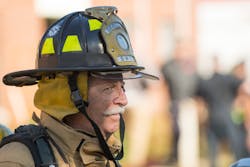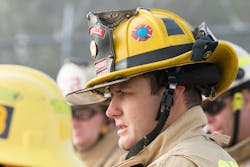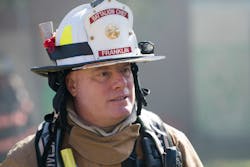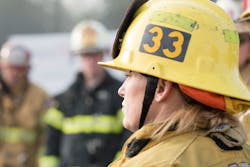The firefighting helmet has a long and storied history. For some, it’s part of their identity as firefighters. The emotional, personal attachment that firefighters feel for their helmet can in part be summed up in a reply that I received from a firefighter who works for me when he was directed to turn in his helmet that had aged out after 10 years: “You can have my helmet when you pry it from my cold, dead hands.” I laughed. Of course, he gave it to me. As important as the helmet is emotionally and aesthetically to the firefighter, its true intention and value lies in the protection that it gives the firefighter’s head.
Job one
The firefighting helmet isn’t a billboard for experience nor a badge of courage. It’s one of the more important aspects of the firefighter protective ensemble. It protects the area that generates critical thinking and physiological actions by protecting the firefighter’s head from fire and falling objects. However, it also keeps water and embers from going down the neck behind the firefighter’s collar as well as provides limited face and eye protection. All of the factors must be considered in selecting a helmet.
I ask the question to line firefighters, “What’s most important to you about your helmet?” Unfortunately, some rate the preference for the appearance/look of the helmet or the fit of the helmet almost equal to its capability to protect from impact and heat. (Editor’s note: Although the helmet standards and testing for NFPA 1971: Standard on Protective Ensembles for Structural Fire Fighting and Proximity Fire Fighting are very rigorous, they are just minimum standards.)
So, how do you select a helmet? The answer begins with your response to the following questions: Why are you looking for a new/different helmet, and what’s your needs assessment? Your answer could include: the current contract is about to expire; you want to investigate new technology and design; you have concerns about durability issues; you incurred injuries while wearing your current helmet; or you just aren’t happy with your current helmet.
Whatever the need, do some research. Collect data and information. Find out what’s on the market. I recommend going to a trade show if you have that ability, to collect information in one place. The ability to vet information about products, including to confirm or refute claims in real time and in person, is very beneficial.
Go on the internet/YouTube to see videos of how products are made and tested.
Another suggestion: Reach out to an organization (local, state, national, international) that you or your department belongs to or call a neighboring department.
Also: Schedule a day when manufacturers can come to your location to show you what they have. (See “Show & Tell” sidebar.) Some firefighters tell me that their departments are too small and believe that manufacturers will not come to them. A potential solution is to band together with neighboring departments or state organizations and set up a larger manufacturer presentation day. A single department that requires 10 or 20 helmets might not get anyone’s attention, but, say, five fire departments that require 50 or more helmets total—or a state or regional “presentation day”—will get manufacturers thinking.
Obviously, helmets can be different. Materials can be leather or molded composite. (An interest in leather might be primarily because of style, tradition and longevity; composite helmets bring cost, weight and durability advantages over leather.) The design can be traditional, metro or European, and the finish can be matte or glossy. Eye protection can come in the form of a 4-inch curved design, NFPA flip downs, a retractable visor system, such as the Defender recessed, or goggles. (Not all helmets come with all eye and/or face shields.) A chin strap can be of the two- or four-point configuration. Soft goods can be garnered in removable/reattachable types. Impact caps can be incorporated for thermal (versus just the shell) and/or impact (versus suspension) protection. Fit can be specified in consideration of comfort, balance, coverage, ergonomics and/or weight.
Consideration of helmets that are made in the United States should be rooted in the reliability of the supply chain and of customer service.
Editor’s note: Regardless of what you hear or read, all NFPA 1971 helmets must meet the same testing certification requirements.
It’s difficult to truly test helmets by just putting them in the field. How can you ensure that each helmet will see the same number of fires, extrications, dumpsters, vehicle fires, etc.? Even if you test four helmets and the same firefighter wears them, how can you ensure the same situations for each one from one shift to the next, from one week to the next, from one month to the next?
You can evaluate the fit, but the helmet should be worn over a period of time, which probably will depend on the time that you’re afforded based on how quickly that you need to recommend or select. It should be evaluated in full PPE, including SCBA and on air with hood in place and also in nonfire uses, such as extrications in full PPE. That will give you a look at how the helmet interfaces and moves with the ensemble in a physical evolution. You can simulate operational use with physical evolutions in a static environment; that will assist you in a side-by-side evaluation.
If you have access to a burn building, you can evaluate the thermal protection and movement in a “simulated” fire evolution. The adage, “Practice like you play,” applies here. Subject each helmet to the same conditions and movements that you would experience on the fireground and performing an extrication. Climb an aerial ladder. Pull ceiling with pike poles. Lay out an attack line from the apparatus to a front door, and move that line through a building or up stairs. Use the jaws or cutters on a junk automobile.
Besides the big red truck, the firefighting helmet is an item that’s symbolic of being a firefighter, but it’s not a showpiece. It’s an important part of the firefighting PPE ensemble and must be treated that way.
Show & Tell
Inviting a helmet manufacturer to your facility is an excellent way for you to begin to get your arms around the kind of design and construction of a helmet that will serve you/your crew. Consider what follows as a way to formalize your request and to clearly explain your expectations for the visit.
The (Name) Fire Department has approximately (number) personnel that use firefighting PPE. In the interest of investigating new helmet technologies, innovative design, and enhanced or updated products, and for the purpose of establishing a new structural firefighting helmet specification, (Name) Fire Department’s Firefighting Personal Protective Equipment Committee will conduct evaluations for structural firefighting helmets.
The evaluation for structural firefighting helmets is planned to begin no later than (date), to properly assess all aspects of a helmet: protection, fit, function and durability.
All manufacturers that produce their products in the (United States, North America, etc.) are invited to participate. The following parameters will apply to all products and all participants, and a minimum of six helmets of the current traditional style of (Name) Fire Department shall be submitted:
- Of the six helmets that are submitted, two must be (color) and four must be (color).
- Helmets that are submitted must have impact-cap technology.
- Of the six helmets that are submitted, a minimum of two must follow our department’s face-shield specification. If desired, the other four may include a different NFPA-certified face shield.
- Of the six helmets that are submitted, one (chosen randomly) must be used for destructive testing and examination internally by (Name) Fire Department.
- All products must meet all of the current requirements of the NFPA 1971: Standard on Protective Ensemble for Structural Fire Fighting and Proximity Fire Fighting.
- Participating manufacturers will ensure that correct sizing and fit is provided for each evaluator who wears their product.
- Participating manufacturers must ensure that training is provided to meet any applicable aspects of the current issue of NFPA 1851: Standard on Selection, Care, and Maintenance of Protective Ensembles for Structural Fire Fighting and Proximity Fire Fighting, including, but not limited to, the published helmet-inspection protocol.
- (Name) Fire Department requires protective ear flaps and internal soft goods that are able to be removed and replaced in an end-user-friendly fashion.
- The same helmet material that currently is specified is preferred, unless otherwise allowed by (Name) Fire Department. The committee will review and might accept into the evaluation alternative materials or technology at its discretion.
- Participating manufacturers must provide the appropriate NFPA 1971 Technical Data Package for their product before being accepted to participate.
- The NFPA-compliant label must stay attached and be legible for the usable life of the helmet.
- Any style, design concept and innovation that already is included as part of the current (Name) Fire Department specification takes precedent in construction of the helmets that are submitted unless an approved equal or alternative is allowed by (Name) Fire Department.
- At the conclusion of the evaluation, the top finishers may have one of their submitted helmets (chosen randomly) submitted to a laboratory of (Name) Fire Department’s choice to be tested to the NFPA 1971 requirements to confirm its capability to meet those requirements.
- This testing will be done at the manufacturer’s expense. Results will be reported to (Name) Fire Department and the respective manufacturer.
- All helmets that are submitted and accepted for evaluation become the property of the (Name) Fire Department at no cost or expense to (Name) Fire Department.
Also: Insist on a warranty of longer than one year. Cracks seem to be a universal issue, but you might hear “they’re only cosmetic.” Problems that are a result of manufacturing should surface by your first yearly advanced inspecting/testing, but manufacturers warranty, inspection directions and customer-service replies might differ.
As well: Use automatic discounts for late deliveries. Rather than liquidated damages that must go through a bureaucratic process, if your contract stipulates 30-day delivery, then Day 31–45 is an automatic 10 percent discount off of the purchase-order price; Day 46–60 is another 15 percent off of the purchase-order price, etc.
About the Author





